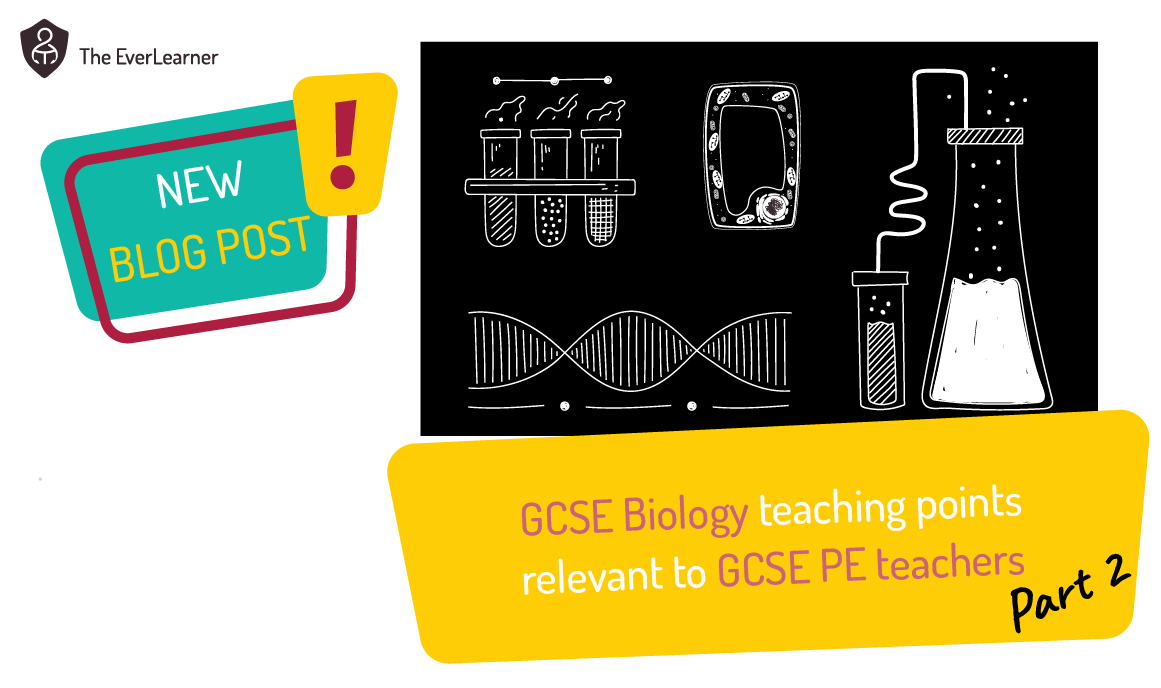10 GCSE Biology Teaching Points Relevant to GCSE PE Teachers (Part 1)
Dear PE teachers,
I wanted to take the opportunity to write a series of ideas that might help you to unite your teaching with GCSE PE with the experiences that students receive in GCSE biology. As you will probably know, there are a whole series of concepts that students learn on both courses but – frustratingly for them – they are taught in slightly different ways with slightly different language or understanding. Therefore, I thought this post might support GCSE PE teachers in understanding their students' experiences as a whole.
Take a look at this preview:
In part 1:
In part 2:
- Reaction time
- White blood cells
- Metabolism
- Nervous system
- Homeostasis and biofeedback
So let’s take this in turn.
1. In GCSE biology, teachers teach… energy release/transfer
This one is true of all the science subjects included chemistry and physics. GCSE biology teachers teach students that energy can only be released/transferred. In other words, energy can neither be produced or destroyed. As many of you will know, “energy production” is common terminology in PE teaching and this needs to change.
Let’s understand this:
In any biological reaction, there are reactants and products. However, energy is neither of these. Take a look here:

In this reaction, there are reactants (oxygen and glucose) and products (carbon dioxide and water) but energy is neither a reactant nor a product. Rather, energy has been released as the reaction occurs.
Let’s assume that the reaction is occurring in muscle tissue and let’s assume that the released energy is going to be transferred into the kinetic energy store (movement). This image can help us to express this:

In fact, this energy does a huge amount of work for us because it represents the idea that glucose and oxygen react in a higher energy state to produce carbon dioxide and water which have a lower energy state. During this reaction, energy is released and is utilised to power muscle contraction.
Exactly the same can be said of the anaerobic system:
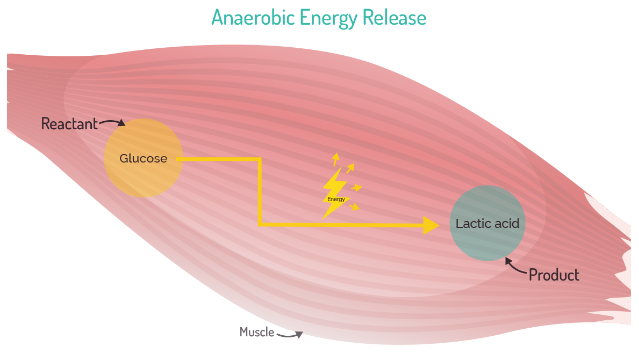
But, on this occasion, the energy release is lesser and means that this system can only be transferred to the kinetic energy store (movement) temporarily. In other words, too much anaerobic energy release leads to fatigue.
So, what should PE teachers do? Here are my suggestions:
- Scrap your use of the term “energy production” and refer to “energy release”.
- When you describe that energy is being utilised for movement, use the term “transferred” ideally by saying that the chemical energy store within glucose is transferred to the kinetic energy store for movement/contraction.
- When you draw the equations for either aerobic or anaerobic energy release, do so as illustrated above, where the reactants have a higher energy state than the products.
- As above, illustrate energy release within the context of muscle tissue and contraction. This helps to show the next destination for the released energy.
2. In GCSE biology, teachers teach… gaseous exchange
This one looks pretty similar in both subjects. Gaseous exchange at the lungs (as well as in other organisms such as via the gills in fish and via the stomata in plants) is taught the same in both biology and PE. Well, actually no. In GCSE biology, teachers ensure that students understand that gaseous exchange is a completely random process based on probability. Let me give you an example:
In PE, we may teach something like this:
And
Unfortunately, if we teach it like this, it is completely impossible for a student to truly understand what is happening. Therefore, we need a tweak and need to teach like this:
And
This distinction is critical because gaseous exchange occurs as a result of the most basic principle: randomness and probability.
You see, the molecular oxygen in the alveolus is bouncing around randomly. This is based on kinetic theory. Therefore, because there is lots of it in the alveolus, there is lots of it bouncing through the membranes of the alveolus and capillary and into the blood. But, crucially, oxygen also moves in the opposite direction because the same randomness (kinetic theory) is causing this too. However, there is less oxygen in the blood than in the capillary and this causes the majority (net) movement of oxygen to occur from the alveolus to the capillary.
Therefore, if a PE teacher states, “oxygen moves from the alveolus into the capillary” this is wrong. We need to state: “the net movement of oxygen is from the alveolus to the capillary because there is a concentration difference (gradient) and the greater this difference (gradient) is, the greater the rate of diffusion.”
3. In GCSE biology, teachers teach…. proteins
Right, I need to declare something: I love proteins. I mean, I love them!!! They are incredible. If I had my younger life again, I would try to specialise in microbiology and I would hope to study proteins and protein synthesis. Proteins are like little miracles. I have written an entire piece on proteins here.
In PE, the extent of our proteins teaching is often something like this:
- Proteins are found in meat, fish, pulses and nuts.
- Protein is used for growth and repair including the adaptation process.
- Athletes should consider protein supplements post-exercise or training.
- A protein supplement would include a 30g dose.
But all of this teaching fails to hit the intuition of proteins. Therefore, I would like PE teachers to be aware of what students learn in biology and then use this to improve their application in PE.
Let’s start at the beginning: human beings, like all other organisms, need to recruit external resources in order to live. These resources are often obvious, such as the need for oxygen for respiration or water for cell function. But human beings, crucially, also need to ingest proteins. Specifically, human beings need the amino acids that are the building blocks of proteins. It works like this:
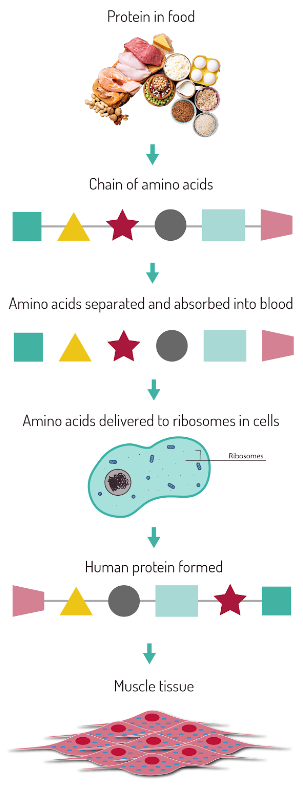
In some ways, this seems counter-intuitive: we eat protein in order to break the protein up into amino acids but then we rebuild those amino acids into proteins. There are two reasons why this is necessary:
- Proteins are insoluble and cannot be absorbed into the bloodstream: they are too large. Only amino acids can be absorbed because they are small (we refer to them as “soluble products”).
- The proteins that are built within the body are highly specific and cannot be acquired from food.
Proteins are highly specialised and highly complex 3D molecules that do the majority of all the work within cells. They are made up of amino acids and, in some cases, hundreds of amino acids. Human beings cannot function without them. Therefore, consuming protein and the ingestion of amino acids is critical for healthy human life. Examples of proteins are hormones, enzymes, antibodies, muscle-cell filaments and also haemoglobin.
Now, tell me that this isn’t cool! Tell me that this knowledge does not help a PE student. You won’t be able to because it is absolutely magnificent. Once again, I encourage you to read further in my previous blog post entitled "What are proteins? A guide for PE teachers."
4. In GCSE biology, teachers teach…. muscle tissue
In some ways, this is the most nuanced inclusion in this article but I want you to know that biology teachers teach muscle to be a “tissue” and this is placed within the students’ understanding of biological organisation:
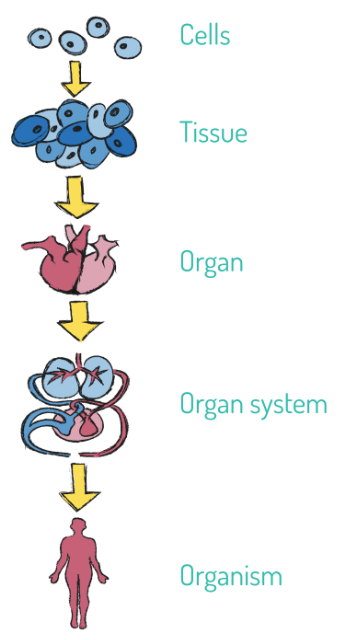
I find this awareness to be really useful in PE because it allows me to place my language accurately. When I describe a muscle, I use the term “muscle tissue” such as “the muscle tissue of the biceps” but it also allows me to place the role of muscle in other teaching such as the cardiovascular system (above) or the digestive system below:
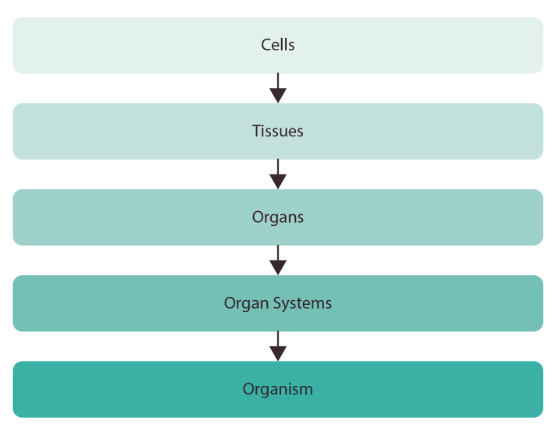
Which would become:
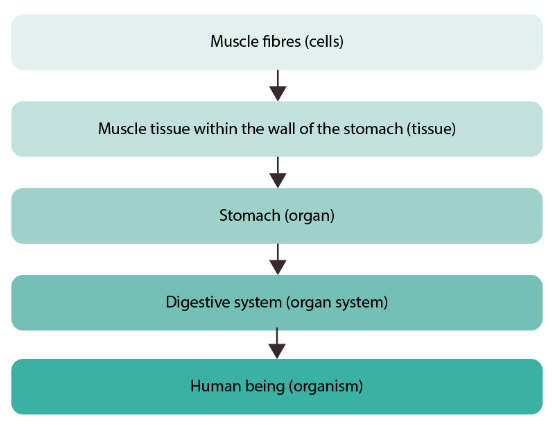
Finally, biology teachers teach about the “specialisation” of muscle tissue. Students are taught that muscle tissue is made up of long, contractile proteins (see above for proteins) and that these proteins contain lots of mitochondria because mitochondria are the site of aerobic energy release (see above).

Biology students learn to compare this specialisation to that of a nerve cell or sperm cell:
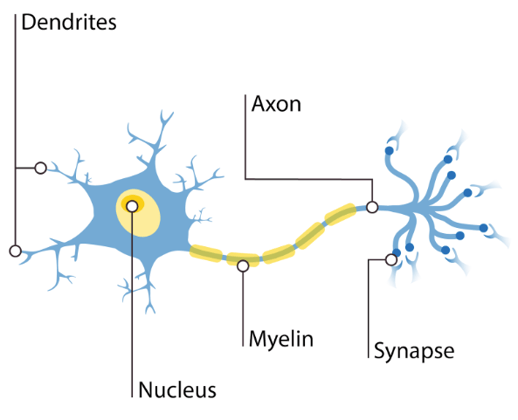

Therefore, students are able to compare specialised cells (gametes) such as sperm and specialised cells such as muscle.
5. In GCSE biology, teachers teach…. digestion
I have actually touched on many of the considerations on this one already in the post but I want to make a special mention of digestion. Firstly, I feel strongly that digestion should be a far greater element of PE studies. Food, diet, hydration, and digestion are fundamental knowledge areas for PE students and I do not believe that our current sector-wide offers honour this importance sufficiently.
Let’s start at the beginning. Human beings, like all other organisms, need to recruit external resources in order to live. These resources are often obvious, such as the need for oxygen for respiration or water for cell function. But human beings, crucially, also need to ingest carbohydrates, proteins, fats, fibre, vitamins and minerals in order to live. Human beings extract these nutrients from food (and drink). In other words, human beings, like other animals, are heterotrophs: their nourishment is derived from food chains. This differs from plants, for example, which are phototrophs: plants derive their nourishment from light energy.
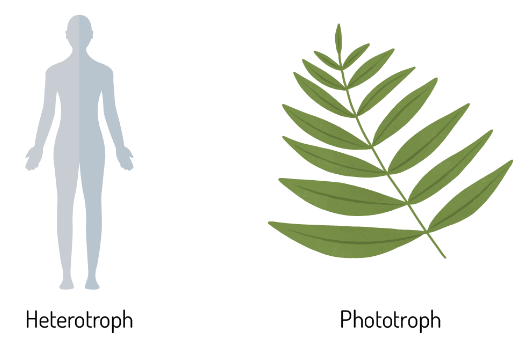
So, we have this clear: human beings derive nourishment from food chains.
The problem is food chains (such as fats, proteins and carbohydrates) cannot be absorbed by the body. They are too large to get into the bloodstream and be transported to the cells. Therefore, humans use digestion to break down food chains into smaller components.
Let’s take a moment to get our terminology right here.
- Human beings take on food chains. These are known as “insoluble” because they are too large to pass into the bloodstream.
- Human beings “digest” these food chains to make them smaller.
- Once digested, we refer to the products of digestion as “soluble”. In other words, they are now small enough to pass into the bloodstream.
I would like to summarise this idea into an image:
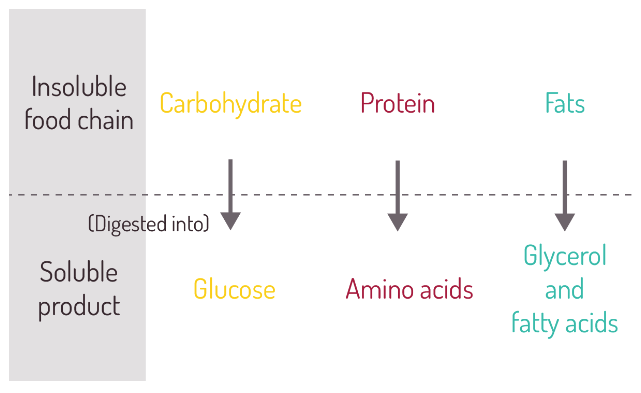
We could take this far, far further; and GCSE biology does. To do so, read my entire post on digestion here.
So, these are five areas that PE teachers can teach differently or more accurately in order to make the connection with biology learning. In my experience, you will also find this a really worthwhile pursuit and you will become more confident with your own delivery and explanations.
Look out for part 2 in the coming weeks, which will feature the next five topic areas.
Thanks for reading.
%20Text%20(Violet).png)
